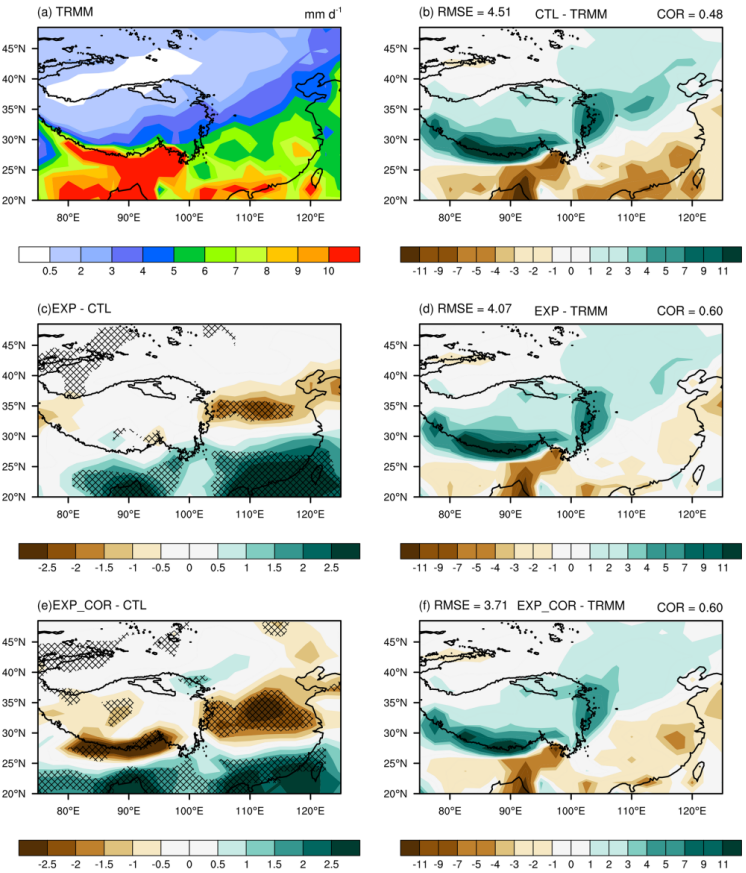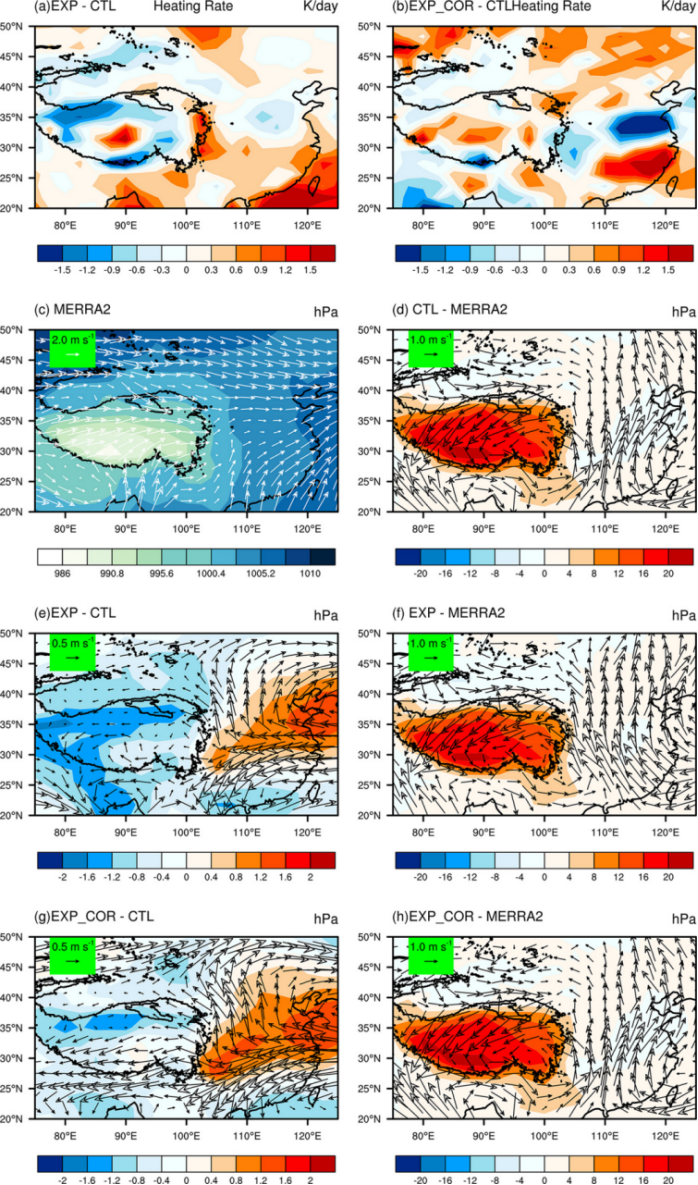The heat exchange between land surface and atmosphere (mainly including sensible and latent heat) is a significant factor impacting the energy distribution among land surface, atmosphere and deep soil, and further impacts the thermal and dynamic processes of the atmosphere. The complexity of land cover types increases the complexity of heat exchange between land and atmosphere. In addition, due to the different effects of sensible and latent heat fluxes in the heat exchange process, the distribution of solar radiation received by the surface between sensible and latent heat regulates the related atmospheric processes. All current global climate models (GCMs) utilize only grid-averaged surface heat fluxes (about 100-200 km resolution) to drive the atmosphere, and thus their subgrid horizontal variations and partitioning are absent. This can result in many simulation biases.
To address the above problem, Associate Professor Wang Yong’s Research Group from the Department of Earth System Science (DESS), Tsinghua University parameterizes the subgrid heat flux of land surface in the global climate model (GCM), and evaluates its improvement effect on climate simulation. The new scheme reduces the bias of the current climate model in simulating the summer precipitation in the eastern and southern margins of the Tibetan Plateau (TP), and reveals the important role of the subgrid variation and partitioning of land surface heat fluxes in the simulation of water cycle and energy cycle in the TP. The related results were published online in Geoscientific Model Development as an article titled “Climate impacts of parameterizing subgrid variation and partitioning of land surface heat fluxes to the atmosphere with the NCAR CESM1.2 on January 4, 2023.
In the previous research, to introduce the subgrid variations of surface heat flux, the research group proposed to use land surface model diagnosis to obtain the statistical distribution of subgrid heat flux, randomly sample from the distribution, and drive several groups of independent planetary PBL s (PBLs) and convection processes online (Sun et al., 2021). This scheme can significantly improve the simulation of summer precipitation in eastern China, but brings no obvious improvement around the TP.
The original scheme of the research group did not consider the potential relationship between the subgrid sensible heat flux and the latent heat flux, that is, the subgrid partitioning of the surface heat fluxes. To address this problem, the research group proposes a novel improvement scheme, that is, introducing the correlation coefficient of subgrid sensible heat and latent heat fluxes, partitioning the randomly selected sensible heat and latent heat fluxes according to the correlation coefficient, and then driving the PBL and convection process, and averaging the obtained results and transmitting them to other physical processes. The simulation results of the new scheme maintain the improvement effect of the original scheme on summer precipitation in eastern China, and significantly reduce the excessive biases of the current global climate model in summer precipitation simulation in the eastern and southern margins of the TP (Fig. 1).

Fig. 1. Spatial distributions of JJA (June-July August) mean precipitation for (a) TRMM, the biases of (b) CTL, (d) EXP, and (f) EXP_COR with respect to TRMM, and the differences (c) between EXP and CTL and (e) between EXP_COR and CTL.
Further analysis shows that the improvement of precipitation simulation in the eastern edge of the TP mainly comes from the reduction of convective precipitation generated by the convective parameterization scheme, while the improvement in the southern margin of the TP results from the reduction of large-scale precipitation that can be analyzed at grid scale. The influencing mechanisms are as follows: after considering the variations and partitioning of subgrid surface heat fluxes, the heating rate of the PBL from northern China to the eastern edge of TP decreases, the lower atmosphere tends to be stable, local convection is suppressed, and convective precipitation decreases; On the southern edge of the TP, the water vapor transport from the Bay of Bengal is blocked by the abnormal easterly airflow, resulting in the decrease of large-scale precipitation (Fig. 2).

Fig. 2. Spatial distributions of the differences of JJA-mean PBL heating (a) between EXP and CTL, and (b) between EXP_COR and CTL, SLP superposed by the vector ��⃗ from (c) MERRA-2, and the differences (d) between CTL and MERRA-2, (e) between EXP and CTL, (f) between EXP and MERRA2, (g) between EXP_COR and CTL, and (h) between EXP_COR and MERRA2.
Besides precipitation, this study also comprehensively evaluates the simulation performance of global surface heat fluxes, clouds, 2-meter temperature and other variables after the introduction of the new scheme. The results show that the new scheme is stable in the simulation of key variables. The new scheme is not dependent on the specific parameterizations of the PBL and convection processes. Therefore, it is conveniently applied to other GCMs
Yin Ming, a doctoral student of Grade 2021 in the DESS, Tsinghua University, is the first author of the paper, and Associate Professor Wang Yong of the DESS, Tsinghua University is the corresponding author. Co-authors include Han Yilun, a postdoctoral fellow in the DESS, Tsinghua University, Wang Bin, a distinguished visiting professor in the DESS, Tsinghua University and a researcher in the Institute of Atmospheric Physics, Chinese Academy of Sciences. This research is supported by the National Natural Science Foundation and Key Research & Development Projects of the Ministry of Science and Technology.
Full-text link:
Yin, M., Han, Y., Wang, Y., Sun, W., Deng, J., Wei, D., Kong, Y., and Wang, B.: Climate impacts of parameterizing subgrid variation and partitioning of land surface heat fluxes to the atmosphere with the NCAR CESM1.2, Geosci. Model Dev., 16, 135–156, https://doi.org/10.5194/gmd-16-135-2023, 2023.
Related research paper:
Sun, W., Wang, B., Wang, Y., Zhang, G. J., Han, Y., Wang, X., and Yang, M.: Parameterizing Subgrid Variations of Land Surface Heat Fluxes to the Atmosphere Improves Boreal Summer Land Precipitation Simulation with the NCAR CESM1.2, Geophys. Res. Lett., 48, e2020GL090715, https://doi.org/10.1029/2020gl090715, 2021.
Written by Wang Yong
Edited by Wang Jiayin
Reviewed by Zhang Qiang